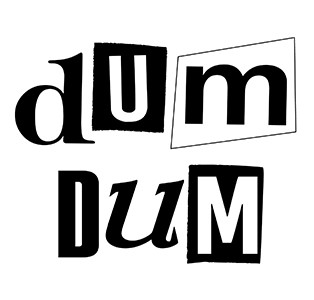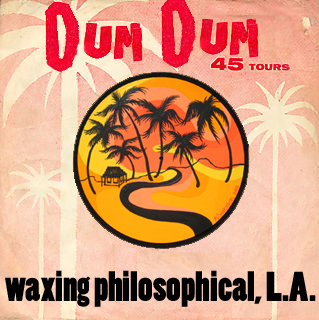“Waxing Philosophical, L.A.” is DUM DUM’s Tuesday column written by Christina Gubala, co-founder of L.A.’s premier cassette-tape label, Complicated Dance Steps. A die-hard vinyl collector, you can find her spinning records at local bars near you.
Our city has a continuing history thick with vinyl love, now more than ever with record shops opening their doors instead of shuttering. Each week, Gubala breaks down a fresh new wax purchase, and writes about the record store as well, mapping it as part of L.A.’s history in the making.
“The best dollar bin in L.A., that’s what I need to find today,” I mused aloud to my friend who, without a pause for breath offered, “Oh, so Amoeba.” I could have uttered that sentence in front of any frequent record buyer in Los Angeles and gotten the same response. There is no way around the fact that when it comes down to it, Amoeba Records in Hollywood will win every time. Sit for a second and conjure an image of a completely unfindable record. Someone at Ameoba Hollywood has seen it come through their bins. Dream up a culture from any corner of the globe, during any era. They have a section for it. 8-tracks? Check. 10” wax? Check. Cassettes old and new? Check and check. Hell, I’d place bets that they have a reel to reel stash in there somewhere.
Amoeba is the city’s most reliable resource for concentrated awesome, and it transcends just their product. Their an institution committed to their causes–the rehabilitation of New Orleans through their Tipitina Foundation, their green initiatives and reminders at every register, their standing offer to dog owners: “DOGS DIE IN HOT CARS…so bring yours in the store!” Amoeba’s charity work delves so much deeper than that sentence would imply, but as a casual shopper, it’s these compassionate details that stick with you. And it’s these details that establish that sense of belonging.
Don’t get me wrong–Amoeba Hollywood overwhelming. There are two stories, one of which is dedicated to DVDs (rare ones at that… I found a copy of the animated version of Watership Down and Neil Young’s Live In Berlin there), and the second of which is dedicated to an ocean of music. There are records crawling up the walls. In the back room, records for days. It’s like Willy Wonka’s chocolate factory for the ears in there! The first time I visited, I think I may have perched on the stairwell for about 20 minutes, drooling, hyperventilating, contemplating ways to freeze time. I have never been anywhere like it (their San Francisco and Berkeley locations, while senior, don’t hold a candle to Amoeba L.A.’s majesty).
The recent arrival bin usually contains at least one land mine record per trip (land mine record = upon finding it, a mind explosion). The gig posters adorning the walls are the stuff dreams are made of, especially if you have any romantic notions of the German subway. To the left, rock n’ roll is king: reissues of Nirvana’s Nevermind, The Grateful Dead’s American Beauty, The Kink’s Give The People What They Want, and Neu’s Neu position themselves alongside every Radiohead record, Washed Out’s Within and Without, and Bill Callahan’s Apocalypse as if to say, “obviously.” In the center, a moat of used CDs offer space for patrons to squeeze while they view Amoeba’s world-famous in-stores (William Shatner is going to be there later this month, on that same stage where Henry Rollins and Paul McCartney have stood). And to the right, to my wallet’s consistent dismay, the most complete international selection of vinyl in the city. When I was buying reggae records once a week for my DJ night, I knew that one trip to Amoeba a week would keep my set legitimately and consistently interesting. They’re reliable in their vastness, but this isn’t what makes the superstore special.
Amoeba is like a safe-haven. To enter the doors is to be among friends, among people who understand how special it is to be where they are. And honestly, it’s a fantastic date destination. While on my dollar record mission this evening (more on this shortly), two couples giggled at vintage record covers together on either side of me. My own boyfriend was lost somewhere in the back room, probably among the “Experimental” records buried between “Pop Vocals” and “Soundtracks.” My funding had been pretty low this week, so I had limited myself to very strict criteria on this trip: buy the best looking dollar record about which you know nothing, and upon review, see how well your instincts fare. Pretty simple, really. I had to apply blinders while walking straight to the dollar aisle, and then go crazy.
I pulled a stack of 15 potential records in about 20 minutes. An Emmylou Harris record from 1987, a Sheena Easton record featuring a raven-haired Sheena and no mention of Prince in the liner notes, at least 5 records featuring 1940’s Hawaii paradise jams, a double-disc edition of the musical Evita (I did end up buying that one for my mom), and finally, the chosen one: Ric Ocasek’s 1982 release Beatitude. The cover features Ric’s distinctive mug obscured by purple aviators reflecting the horizon. A standard 1980’s brick wall crumbles behind him to reveal an equally purple freeway-scape. When I clapped eyes on it, it conjured its era so viscerally that I was instantly arrested. I’ve generally appreciated everything Ocasek has put his name on, with the notable exception of Guided By Voices’ Do The Collapse. It’s said he didn’t let Robert Pollard drink while in the studio, and it shows. And I mean that in a negative way.
I had no knowledge of this record, so I figured it was the horse to back. Beatitude isn’t exactly rife with anything groundbreaking, but then its 1982 release date may render that untrue. Unfortunately when you examine music history out of its chronology, you hear it with corrupted ears. I can say, however, this record is nothing if not pleasant. The opening track–and per YouTube searches, the most appreciated on the record–is called “Jimmy Jimmy.” The listener finds his or herself involuntarily singing lyrics from Cars songs over the subliminally familiar intro. Much of the A-side fades to black as I try to conjure it, but thankfully, the B-side boasts a few proper jams that carry the record handily. The first, “Out of Control,” is sexy in it’s synthed out off-kilter rhythm, in spite of it’s subtly krauty cord progressions, and entreats the listener to play it on repeat. The second track worth a damn on the B-side is the album closer, the ebony-hearted “Time Bomb.” The dark apotheosis of the album leaves a sweet taste on the listener’s ears, and I have to say that after listening to it completely twice, I recalled it fondly in spite of its filler. My theory is a mediocre Ric Ocasek track from 1982 is still more enjoyable than, well… almost anything else from the U.S. in 1982. The dollar record challenge proved to be a success!
Amoeba is… a hard place to contain in these pithy descriptions. It’s larger than life as its fantastic neon signage, epic window displays, and blues-inspired murals. It’s important in ways we probably don’t understand yet, and I love it like home. VIVA AMOEBA!
Tuesday, October 11, 2011







